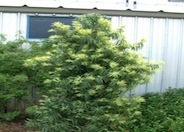
Common name:Japanese Maple
Botanical name:Acer palmatum
This magnificent plant can used as a small tree or shrub. It is deciduous with graceful leaves which have a scarlet color in spring as it leafs out. They turn orange or yellow in fall. It is slow growing to 20', and requires shelter from hot winds.
The leaves of this tree are small, light green in color, and deply lobed. It should also be noted that the tree remains spectacular throughout all seasons. Second picture by Steve Mullany.

Common name:Nandina, Heavenly Bamboo
Botanical name:Nandina domestica
Nandina domestica is a graceful upright shrub that grows from 3 to 6' in height. It gets its name from its bamboo-like growth habit. When thinned from the center it bears a remarkable resemblance to bamboo. It is best used in groups. It can be used in a shaded patio or out in a shrub border with full sun. An interesting feature of Heavenly Bamboo is the bronze color in the new growth when planted in full sun. It also bears clusters of white flowers in the spring.

Common name:Long-leafed Yellowwood
Botanical name:Podocarpus henkelii
This handsome evergreen tree will grow 30-50' high x 15-20' wide. It has beautiful drooping, shiny, green foliage year-round. Leaves are slightly crescent-shaped, 5-7' long when young, shorter when plant matures. Attractive container plant.

Common name:Woolly Yarrow
Botanical name:Achillea tomentosa
Short stems of flat-topped golden flowers accent the deep green, wooly, fern-like leaves of the mat formed by this plant. It is a fine performer in rock gardens and at the front of herbaceous perennial borders.
Yarrows propagate easily from rooted stems or division, which should be performed in the early spring or fall. Following bloom, dead head the plant and divide the clumps when it appears crowded.
If you mulch heavily as recommended in the compost and mulch fact sheets you should not need traditional fertilization. Sustainable landscapes fertilize themselves as soil organisms break down and recycle the dropped leaves into nutrients.
Click in the green box for more information
Designer: Turner Fine Gardens
Photographer: GardenSoft
Incorporate compost 6" into your soil to retain water, reduce compaction, feed earthworms, and provide valuable nutrients to your plants.
Adjust sprinklers to avoid watering sidewalks and driveways.
Develop healthy soil for plants that are vigorous and naturally pest-resistant.